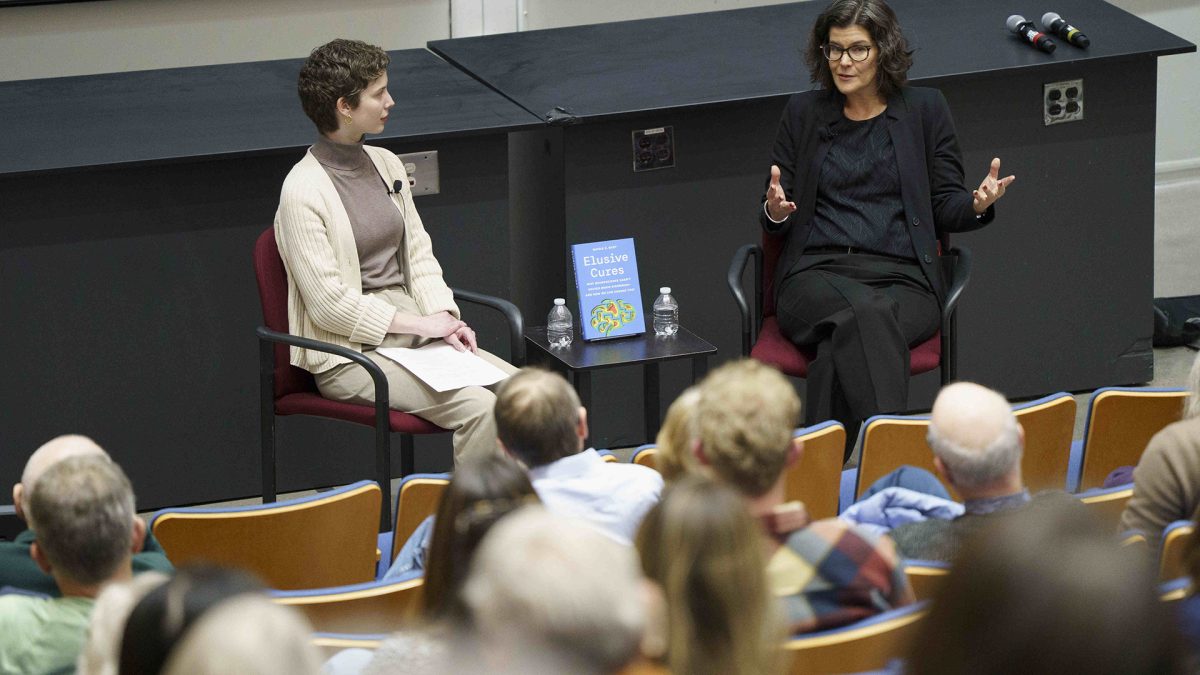Health
Why don’t we have cures for Alzheimer’s, depression?
Neuroscientist says AI, changes in way we think about brain function will likely help speed progress
“Elusive Cures” author Nicole Rust (right) speaks at Harvard Science Center.
Photo by Jodi Hilton
It’s time to change our minds about our brains.
That was the key message neuroscientist Nicole Rust brought to the Science Center on Tuesday on reframing the pursuit of cures for conditions such as Alzheimer’s and Parkinson’s diseases, depression, and schizophrenia.
“We’ve been thinking about the brain in the wrong way, insofar as we’ve been oversimplifying it,” said Rust, a psychology professor at the University of Pennsylvania, who was on campus to discuss her new book, “Elusive Cures: Why Neuroscience Hasn’t Solved Brain Disorders — and How We Can Change That.”
In her talk, Rust recounted how researchers spent decades envisioning brain disorders in terms of linear causes and effects — what she called “domino chains” of faulty genes to neuroanatomy to dysfunction. Their goal was simply to “find the broken domino and fix it.”
As a result, researchers spent their time looking for single genes and magic-bullet cures, making precious few breakthroughs. Many current medications were first developed in the mid-20th century. And they remain the state of the art because few better alternatives have come along in the intervening years despite billions spent on research.
In the early 1990s, researchers identified a genetic mutation associated with Alzheimer’s disease and its signature symptom, the accumulation of amyloid plaques. Scientists raced to develop amyloid-clearing drugs, but those turned out to have only modest benefits (and harmful side effects), and the disease remains uncured.
By the second decade of this century, many researchers and funding agencies were voicing their frustration with the pace of advance.
“The story I want to tell you is ultimately optimistic because I really do think that we are on the cusp of some amazing breakthroughs following new developments in artificial intelligence and biotechnology.”
Rust quoted Thomas Insel, former director of the National Institutes of Mental Health, who lamented that during his 13-year tenure the agency funded $20 billion in research and made many exciting discoveries, yet somehow all that yielded few improvements for patients.
“I don’t think we moved the needle in reducing suicide, reducing hospitalizations, or improving recovery for the tens of millions of people who have mental illness,” said Insel.
But now, Rust noted, modern neuroscience is re-envisioning its approach, moving “toward thinking about the brain as a complex adaptive system.”
Disorders such as schizophrenia are not products of single genes but hundreds of genetic variants. Moreover, many of these variations regulate other genes, adding more layers of intricacy.
Even when accounting for all the genetic mutations, researchers remain unable to predict which people will develop disorders and which will not. As Rust wrote, “If we want brain research to be impactful, we must stop dreaming of magic bullets and embrace complexity.”
“These dynamic systems are infamously hard to control in meaningful ways,” he told the audience. “Case in point: We cannot control the weather.”
Luckily, these realizations are dawning just as we are developing powerful new tools such as artificial intelligence and machine learning.
For example, AlphaFold, an AI system developed by Google DeepMind, solved one of the most complex issues in biology: the “protein folding problem.” Essentially, the program was able to predict the 3D structure of nearly every known protein, based on amino acid sequences.
Such successes provide hope for similar breakthroughs in brain disorders.
Now, Rust believes, science is ready to understand the brain as a dynamic, adaptive, self-regulating system, and make real progress in deciphering our most enigmatic organ.
“The story I want to tell you is ultimately optimistic,” she said, “because I really do think that we are on the cusp of some amazing breakthroughs following new developments in artificial intelligence and biotechnology.”
Rust noted that she initially didn’t feel that way. But through writing the book, she gained historical perspective and came to understand brain research as part of the typical scientific process.
She likened current work to the quest to measure temperature in the 17th century, a period of iteration when tools and questions improved through trial and error.
“I started this book project as kind of a personal journey,” Rust said. “I started pessimistic as a brain researcher, because I could not see the through line between what we were doing and what society needs from us. And I ended up optimistic. … I understand why treating some brain and mental conditions is so incredibly formidable. I believe that for the first time in history, we’re ready to face those challenges head-on.”

